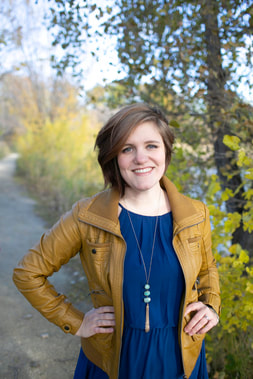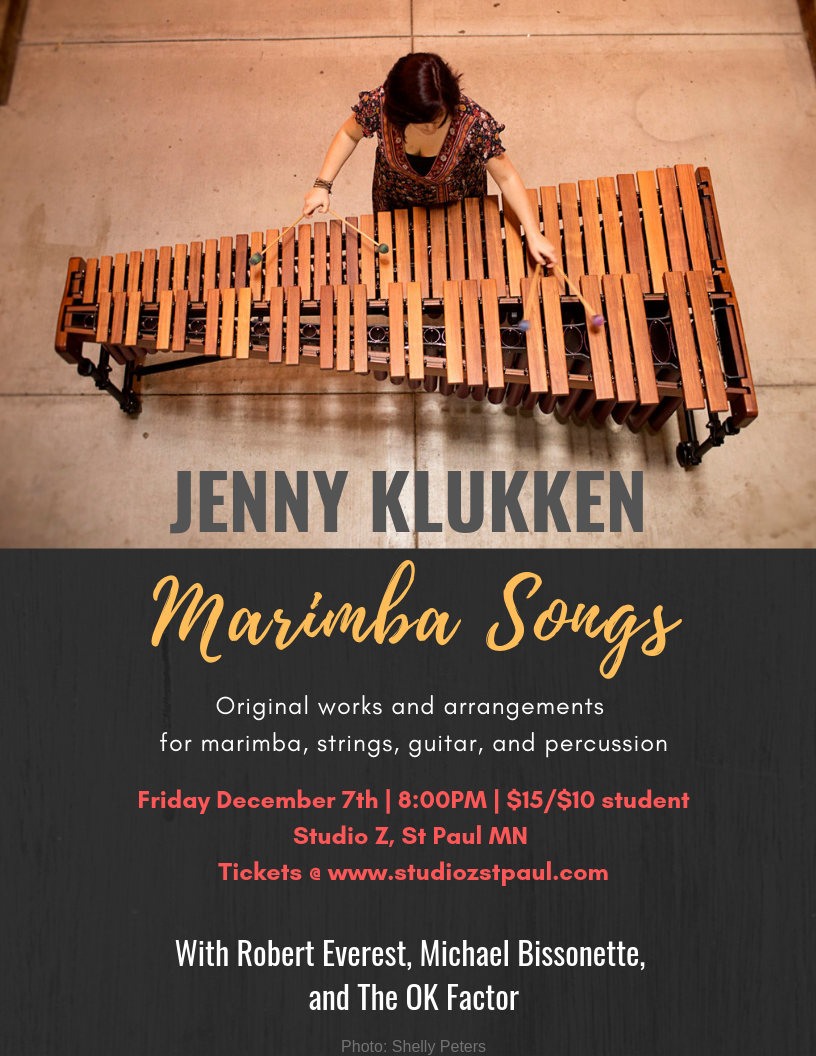
In the spring of 2018, Jenny Klukken traveled to Paris to study marimba, composition, and improvisation with Eric Sammut, and to compose works for marimba that incorporated her unique approach to the instrument. The Studio Z performance will premiere works she composed in Paris, plus various works that have been collectively arranged by Jenny Klukken and guest musicians Robert Everest (guitar/vocals), Michael Bissonette (percussion), and The OK Factor (violin: Karla Colahan, cello: Olivia Diercks). We interviewed Jenny to learn more about the new works and her artistic background and inspirations.
I played the piano as a child and studied classical percussion in college. I discovered the marimba when I was a freshmen in college and it became clearer to me throughout my schooling that it was my main instrument. It wasn’t until after college that I found myself wanting to compose for myself. I would search through repertoire, searching for inspiration for what to do next with my instrument. While I appreciated other marimbists’ craft, none of the repertoire felt like something I was compelled to play myself. I never formally studied composition, but have been writing songs and geeking-out about music theory since I was a kid. I grew up playing and listening to a lot of jazz, bluegrass, and gospel music, so writing and playing tunes instead of through-composed pieces has always felt like home. I hesitate to call myself a full-on jazz musician, but more of a jazz/world/classical/cross-over instrumentalist and composer (though that is much more of a mouthful, isn’t it?).
How are you able to incorporate other genres into your compositions while keeping your own unique voice and style?
I most often find my compositions sounding like Latin, American folk, and/or jazz music. The last two are pretty unusual to find a marimba in, which is fun to play with. I love to pull rhythmic ideas from these genres while interjecting passages that could only be pulled off by a marimba. The years in college I spent practicing four-mallet permutation exercises will pop up into something that otherwise sounded very non-classical. I think it is fun to write music that doesn’t completely slip into one genre and to balance the line between sounding extremely rehearsed and improvisational. I constantly aim to be able to improvise on the marimba with the same virtuosity
Tell us about your experience studying with Eric Sammut in Paris.
I received the “Next Step” grant last year from the Metropolitan Regional Arts Center to travel to Paris and study marimba, composition, and improvisation with Eric Sammut for one month. If you don’t know Eric Sammut, he is a pillar of the marimba world; a phenomenal composer and performer who first became widely known in the early 90’s, and one of the only improvising marimbists I know. I rented a small flat in Paris (with just enough room for a 5 octave marimba) that was walking distance to Eric’s home. Twice a week, Eric would meet me there for a 2+ hour lesson. Most marimbists know that Eric is an extraordinary player and composer, but I soon learned that he is also an incredibly kind, humble, and generous person. Lessons alternated between improvisation exercises and workshopping compositions. Our time usually ended with espresso and chats about Eric’s interesting life and inspirational approach to music and the marimba. I have always had to translate conversations about accompanying and soloing through my marimba lenses, and this was the first time I talked to someone who had explored the marimba’s capabilities in a jazz ensemble setting. His thoughts about voicing chords, arranging, and soloing according to the marimba’s timbre were groundbreaking for me. Outside of practicing and composing, I spent my time exploring Paris.
How did you go about collectively arranging pieces with the five guest musicians?
I’ve played with all of these musicians before, but pairs of them have never performed with each other. It was helpful to have a musical history with them all as I began writing for each of them specifically. All of the pieces that we’re playing on December 7th are written as charts, save one through-composed piece I wrote last spring. I started getting ready for a concert like this while I was in Paris and spent hours writing out through-composed charts for everyone. Once I got into my first rehearsal with this music, it was very clear to me that this room of musicians (including myself) was going to function better off of charts. I feel more at home reading charts rather than composed parts, and I also enjoy hearing musicians put their own personal touches on my ideas. I am very happy with where these pieces ended up. I enjoy the thrill of not knowing exactly how everything is going to go: how my cadenza might end up, when a new burst of energy will arise, or when there might be a musical shift between players. I think the classical marimba world could use more of this; more free-playing and making music for the moment. This is where I have found my voice as a musician, and I look forward to sharing it with everyone at Studio Z that night.



 RSS Feed
RSS Feed
